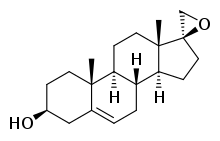BNN-20
BNN-20, also known as 17β-spiro-(androst-5-en-17,2'-oxiran)-3β-ol, is a synthetic neurosteroid, "microneurotrophin", and analogue of the endogenous neurosteroid dehydroepiandrosterone (DHEA).[1][2] It acts as a selective, high-affinity, centrally active agonist of the TrkA, TrkB, and p75NTR, receptors for the neurotrophins nerve growth factor (NGF) and brain-derived neurotrophic factor (BDNF), as well as for DHEA and DHEA sulfate (DHEA-S).[2][3] The drug has been suggested as a potential novel treatment for Parkinson's disease and other conditions.[2]
 | |
| Clinical data | |
|---|---|
| Other names | BNN20; 17β-Spiro-(androst-5-en-17,2'-oxiran)-3β-ol |
| Identifiers | |
IUPAC name
| |
| PubChem CID | |
| ChemSpider | |
| ChEMBL | |
| Chemical and physical data | |
| Formula | C20H30O2 |
| Molar mass | 302.458 g·mol−1 |
| 3D model (JSmol) | |
SMILES
| |
InChI
| |
In 2011, the surprising discovery was made that DHEA, as well as DHEA-S, directly bind to and activate the TrkA and p75NTR with high affinity.[3] DHEA was subsequently also found to bind to the TrkB and TrkC with high affinity, though it notably activated the TrkC but not the TrkB.[4] DHEA and DHEA-S bound to these receptors with affinities that were in the low nanomolar range (around 5 nM), although the affinities were nonetheless approximately two orders of magnitude lower relative to the highly potent polypeptide neurotrophins (0.01–0.1 nM).[3][4] In any case, DHEA and DHEA-S were identified as important endogenous neurotrophic factors.[3][3] These findings may explain the positive association between decreased circulating DHEA levels with age and age-related neurodegenerative diseases.[2]
Subsequently, a series of spiro derivatives of DHEA that had been synthesized and assessed in 2009 as potential neuroprotective agents was re-investigated.[1][2] Of these, BNN-20 was assayed and found to directly bind to and activate the TrkA, TrkB, and p75NTR.[2] In addition, it was found to cross the blood–brain barrier and to have strong neuroprotective effects on dopaminergic neurons in vivo in a mouse model of dopaminergic neurodegeneration, which were dependent, at least in part, on activation of the TrkB.[2] Moreover, unlike DHEA, it lacked any hormonal actions.[2] As such, BNN-20 was described as a BDNF mimetic and was proposed as a potential novel treatment for Parkinson's disease and other conditions, particularly of the neurodegenerative variety, like amyotrophic lateral sclerosis.[2][5]
See also
References
- Calogeropoulou T, Avlonitis N, Minas V, Alexi X, Pantzou A, Charalampopoulos I, Zervou M, Vergou V, Katsanou ES, Lazaridis I, Alexis MN, Gravanis A (2009). "Novel dehydroepiandrosterone derivatives with antiapoptotic, neuroprotective activity". J. Med. Chem. 52 (21): 6569–87. doi:10.1021/jm900468p. PMID 19845386.
- Botsakis K, Mourtzi T, Panagiotakopoulou V, Vreka M, Stathopoulos GT, Pediaditakis I, Charalampopoulos I, Gravanis A, Delis F, Antoniou K, Zisimopoulos D, Georgiou CD, Panagopoulos NT, Matsokis N, Angelatou F (2017). "BNN-20, a synthetic microneurotrophin, strongly protects dopaminergic neurons in the "weaver" mouse, a genetic model of dopamine-denervation, acting through the TrkB neurotrophin receptor". Neuropharmacology. 121: 140–157. doi:10.1016/j.neuropharm.2017.04.043. PMID 28461162.
- Lazaridis I, Charalampopoulos I, Alexaki VI, Avlonitis N, Pediaditakis I, Efstathopoulos P, Calogeropoulou T, Castanas E, Gravanis A (2011). "Neurosteroid dehydroepiandrosterone interacts with nerve growth factor (NGF) receptors, preventing neuronal apoptosis". PLoS Biol. 9 (4): e1001051. doi:10.1371/journal.pbio.1001051. PMC 3082517. PMID 21541365.
- Pediaditakis I, Iliopoulos I, Theologidis I, Delivanoglou N, Margioris AN, Charalampopoulos I, Gravanis A (2015). "Dehydroepiandrosterone: an ancestral ligand of neurotrophin receptors" (PDF). Endocrinology. 156 (1): 16–23. doi:10.1210/en.2014-1596. PMID 25330101.
- Bennett JP, O'Brien LC, Brohawn DG (2016). "Pharmacological properties of microneurotrophin drugs developed for treatment of amyotrophic lateral sclerosis". Biochem. Pharmacol. 117: 68–77. doi:10.1016/j.bcp.2016.08.001. PMID 27498123.